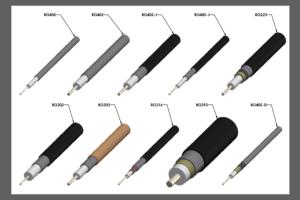Mastering Coaxial Cables: A Comprehensive Guide to Identifying Cable Types

-
Quick Links:
- Introduction
- What is Coaxial Cable?
- Types of Coaxial Cables
- How to Identify Coaxial Cable Types
- Applications of Coaxial Cables
- Common Issues and Solutions
- Expert Insights
- Case Studies
- Conclusion
- FAQs
Introduction
Coaxial cables are essential components in the world of electronics, providing connectivity for a variety of applications including television, internet, and radio communications. However, with numerous types available, identifying the right coaxial cable can be overwhelming. This comprehensive guide aims to equip you with the knowledge to effectively identify different coaxial cable types based on their specifications, applications, and physical characteristics.What is Coaxial Cable?
Coaxial cable, often referred to as coax, consists of a central conductor, an insulating layer, a metallic shield, and an outer insulating layer. This unique structure allows coaxial cables to transmit signals with minimal interference, making them ideal for high-frequency applications.| Component | Description |
|---|---|
| Central Conductor | Conducts the electrical signals; can be made of copper or aluminum. |
| Insulation Layer | Separates the conductor from the shield; typically made of plastic. |
| Metallic Shield | Prevents interference from external signals; made of braided copper or aluminum. |
| Outer Insulation | Protects the cable from physical damage; usually made of PVC. |
Types of Coaxial Cables
There are several types of coaxial cables, each designed for specific applications. The most common types include:1. RG-6
- **Usage**: Widely used for cable television and internet connections. - **Specifications**: 75-ohm impedance, thicker insulation than RG-59.2. RG-59
- **Usage**: Commonly used for low-frequency applications like CCTV systems. - **Specifications**: 75-ohm impedance, less shielding compared to RG-6.3. RG-11
- **Usage**: Preferred for long runs in cable systems due to lower attenuation. - **Specifications**: 75-ohm impedance, thicker than RG-6 and RG-59.4. LMR-400
- **Usage**: Used in wireless communications and antenna systems. - **Specifications**: 50-ohm impedance, excellent shielding for minimal loss.5. RG-8
- **Usage**: Often used for radio frequency (RF) applications. - **Specifications**: 50-ohm impedance, large diameter allowing high power.How to Identify Coaxial Cable Types
Identifying coaxial cable types involves examining several characteristics. Here’s a step-by-step guide:Step 1: Inspect the Cable Jacket
- Look for printed specifications on the jacket, such as "RG-6" or "LMR-400". This is the easiest way to identify the type.Step 2: Measure the Cable Diameter
- Use calipers to measure the outer diameter. For example, RG-6 typically measures about 6.9 mm, while RG-59 measures around 6.15 mm.Step 3: Check the Connector Type
- Different coaxial cables use specific connectors. For example, RG-6 often uses F-type connectors, while LMR-400 might use N-type connectors.Step 4: Determine the Impedance
- Use an impedance meter to check the impedance. Most household cables are 75-ohm, while RF cables are typically 50-ohm.Step 5: Assess the Shielding Type
- Look for braided or foil shielding. Braided shielding is common in RG-6, while LMR-400 might have double shielding for enhanced performance.Applications of Coaxial Cables
Coaxial cables serve various purposes across different industries:- Television Broadcasting: RG-6 is commonly used for satellite and cable TV connections.
- Internet Connectivity: Coaxial cables are vital for broadband internet services.
- CCTV Systems: RG-59 is favored for connecting security cameras.
- Radio Communications: RG-8 and LMR-400 are used in antennas and RF systems.
- Data Transmission: Coaxial cables are also utilized in some networking applications.
Common Issues and Solutions
Identifying and resolving common issues with coaxial cables can enhance performance:1. Signal Loss
- **Solution**: Ensure connectors are secure and check for any damage along the cable length.2. Interference
- **Solution**: Use cables with better shielding and ensure proper grounding.3. Connector Corrosion
- **Solution**: Regularly inspect and clean connectors to prevent corrosion.Expert Insights
Experts recommend understanding the specific requirements of your installation to select the appropriate coaxial cable type. For example, when choosing between RG-6 and RG-59, consider the distance and frequency of the signal.Case Studies
- **Case Study 1**: A telecommunications provider switched from RG-59 to RG-6 for their cable installations, resulting in a 30% improvement in signal strength over longer distances. - **Case Study 2**: A security firm upgraded their CCTV system by using RG-59 cables instead of standard cables, resulting in clearer video feeds and reduced downtime.Conclusion
Identifying coaxial cable types is crucial for optimizing performance in various applications. By understanding the characteristics and specifications of different coaxial cables, you can make informed decisions that enhance connectivity and reduce signal interference.FAQs
1. What is the difference between RG-6 and RG-59?
RG-6 has better shielding and is used for higher frequency applications, while RG-59 is for lower frequency uses like CCTV.
2. How can I tell if my coaxial cable is damaged?
Inspect for visible signs of wear, such as fraying or cuts, and test the signal quality to check for loss.
3. Can I use RG-6 for RF applications?
While RG-6 can be used for RF applications, cables like RG-8 or LMR-400 are better suited for high-performance needs.
4. What tools do I need to measure coaxial cable?
A caliper for diameter measurement and an impedance meter for checking cable impedance are essential tools.
5. How do I improve coaxial cable performance?
Use high-quality cables with good shielding, ensure secure connections, and minimize cable lengths where possible.
6. What are the common connector types for coaxial cables?
Common connectors include F-type for RG-6, RCA for audio/video, and N-type for RF applications.
7. Is it safe to use coaxial cables outdoors?
Yes, but ensure you use cables rated for outdoor use that can withstand environmental conditions.
8. Can I splice coaxial cables?
Yes, but splicing can introduce signal loss; it’s better to use connectors when possible.
9. What is the maximum distance for coaxial cable runs?
For RG-6, the maximum distance is typically around 200 feet for optimal signal quality.
10. How do I choose the right coaxial cable for my needs?
Consider the application, distance, frequency, and compatibility with connectors to select the right cable.
Random Reads